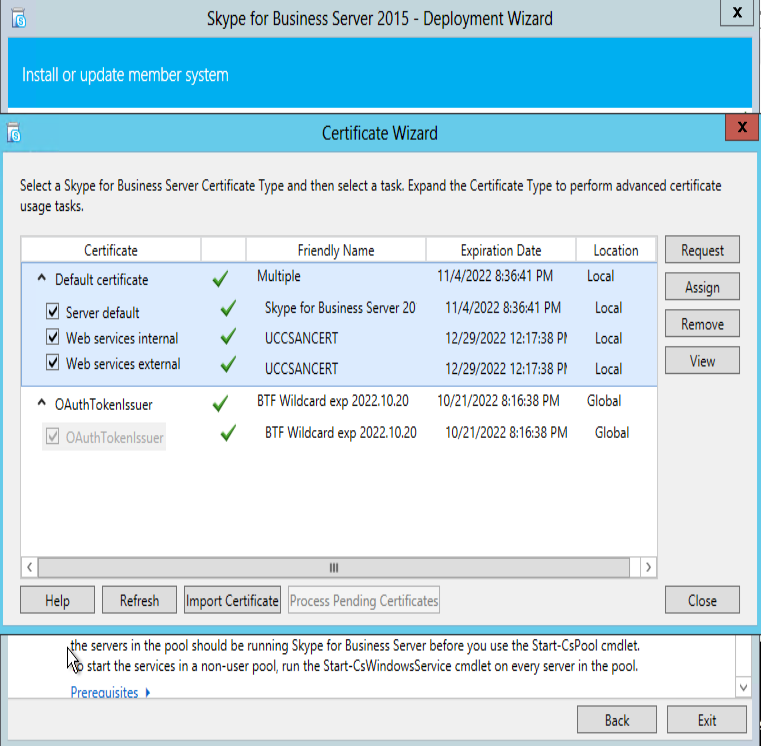Overview of Environment
- Hyper-V virtualized environment hosted on Storage Spaces Direct Windows Server 2019 cluster
- Skype for Business (SfB) Server 2015 Enterprise Pool (Single Server Member) with Front End and Mediation Roles Collocated
- SfB Edge Pool with Single Server Member
- Ribbon Communications (formerly Sonus) SBC
- Centralized SIP Trunking for PSTN integration
- All workloads deployed including Enterprise Voice
- Hybrid configuration with Microsoft Teams operating in Islands mode
Description of Issue Encountered
All SfB Server users both internal and remote reported not being able to join any audio/video conferences. Users could start a Meet Now conference, but no other users could join. No users could dial-in to a conference using the Meeting ID via PSTN. Users could call out to an external phone number and connect successfully. However, they could not add another participant to that call (3-way).
The following are the Lync Server event log errors.
User failed to join the conference.
Microsoft.Rtc.Collaboration.ConferenceFailureException:The operation failed due to a response from the server. For more information, examine the properties on the exception and inner exception.
at Microsoft.Rtc.Signaling.SipAsyncResult`1.ThrowIfFailed()
at Microsoft.Rtc.Signaling.Helper.EndAsyncOperation[T](Object owner, IAsyncResult result)
at Microsoft.LiveServer.Caa.CaaCall.EndTransfer(IAsyncResult asyncResult, Boolean& retry, Exception& caught)
Detected at System.Environment.GetStackTrace(Exception e, Boolean needFileInfo)
at System.Environment.get_StackTrace()
at Microsoft.Rtc.Collaboration.ConferenceFailureException..ctor(String message, Exception innerException)
at Microsoft.Rtc.Collaboration.Conferencing.SendCommandAsyncResult.CreateConferenceFailureException(ConferenceCommandResponse commandResponse, Exception innerException)
at Microsoft.Rtc.Collaboration.Conferencing.SendCommandAsyncResult.ProcessCccpResponse(SipMessageData messageData, responsetype response, Boolean& isPendingResponse)
at Microsoft.Rtc.Collaboration.Conferencing.SendCommandAsyncResult.ProcessStatusMessage(SipMessageData statusMessageData, responsetype response)
at Microsoft.Rtc.Collaboration.Conferencing.StatusMessageReceivedWorkItem.Process()
at Microsoft.Rtc.Signaling.AsyncWorkitemQueue.ProcessItems()
at Microsoft.Rtc.Signaling.QueueWorkItemState.ExecuteWrappedMethod(WaitCallback method, Object state)
at System.Threading.ExecutionContext.RunInternal(ExecutionContext executionContext, ContextCallback callback, Object state, Boolean preserveSyncCtx)
at System.Threading.ExecutionContext.Run(ExecutionContext executionContext, ContextCallback callback, Object state, Boolean preserveSyncCtx)
at System.Threading.QueueUserWorkItemCallback.System.Threading.IThreadPoolWorkItem.ExecuteWorkItem()
at System.Threading.ThreadPoolWorkQueue.Dispatch()
Cause: Administration issues.
Resolution:
Verify that Conferencing Attendant is installed in a supported topology and the dependant Front End servers are functioning correctly.
The Audio/Video Conferencing Server cannot add Conferencing Announcement Service to a conference.
Conferencing Announcement Service failing: sip:LYNCPOOL.biztechfusion.com@biztechfusion.com;gruu;opaque=srvr:Microsoft.Rtc.Applications.Cas:k1Mdhi4-FVSxbeCSuouZogAA Diagnostic Message: Not Available
Cause: The Audio/Video Conferencing Server is not able to reach the Conferencing Announcement Service. This may be due to network connectivity issues or unavailability of the Conferencing Announcement Service. Conference Announcements in audio/audio-video conferences will be unavailable due to this issue. PSTN dial in users will be impacted, as they will be unable to exercise DTMF controls and other PSTN dial in conferencing functionality while in the conference.
Resolution:
Resolution=Please ensure network connectivity and availability of the Conferencing Announcement Service for the Audio/Video Conferencing Server to be able to function correctly. For additional information to troubleshoot the issue, please look at the events AVMCU_E_CAS_UNREACHABLE (Event ID: 32083).
The Audio/Video Conferencing Server cannot add Conferencing Announcement Service to a conference.
Audio/Video Conferencing Server Pool: btfls13fe.hq.biztechfusion.com; Conferencing Announcement Service: sip:LYNCPOOL.biztechfusion.com@biztechfusion.com;gruu;opaque=srvr:Microsoft.Rtc.Applications.Cas:k1Mdhi4-FVSxbeCSuouZogAA; Diagnostic Message: Error Message: The server encountered an unexpected internal error Sip Response Code: 500
Cause: The Audio/Video Conferencing Server is not able to reach the Conferencing Announcement Service. This may be due to network connectivity issues or unavailability of the Conferencing Announcement Service. Conference Announcements in audio/audio-video conferences will be unavailable due to this issue. PSTN dial in users will be impacted, as they will be unable to exercise DTMF controls and other PSTN dial in conferencing functionality while in the conference.
Resolution:
Please ensure network connectivity and availability of the Conferencing Announcement Service for the Audio/Video Conferencing Server to be able to function correctly.
Resolution:
After disabling conferencing in Topology Builder in the properties of the Front End Pool, publishing the topology, and running the bootstrapper.exe program to remove the conferencing features, then reinstalling the conferencing features using the same preceding steps, the issue remained unresolved.
Next, downloaded the latest Cumulative Update (CU) and hotfixes for SfB. Installed the CU and still the issue remained unresolved.
Checked the assignment of SSL certificates to the collocated Front End Server and noticed that the same SSL certificate issued by a public Certificate Authority (CA) with Subject Alternative Names has been assigned to the Default Certificate hierarchy that includes Server default, We services internal, and Web services external. Changing the SSL certificate assignment for Server default using SfB Deployment Wizard to one that contained only the pool name, server name, and sip.domain.name as SANs. After restarting the SfB services, conferencing started working again.
